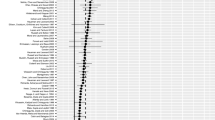Abstract
This paper develops the Latent Symmetric Elasticity Structure (LSES), a market share price elasticity model which allows elasticities to be decomposed into two components: a symmetric substitution index revealing the strength of competition between brand pairs, and a brand-specific coefficient revealing the overall impact of a brand on its competitors. An application of the model to unconstrained cross price elasticities shows that brand-price competition in one market is well-represented by a LSES model in which brand substitutability and elasticity asymmetry are related to average price level.
Similar content being viewed by others
References
Allenby, Greg M. (1989). “A Unified Approach to Identifying, Estimating and Testing Demand Structures with Aggregate Scanner Data,”Marketing Science 8 (Summer), 265–280.
Allenby, Greg M., and Peter E. Rossi. (1991). “Quality Perceptions and Asymmetric Switching Between Brands,”Marketing Science 10 (Summer), 185–204.
Blattberg, Robert C., and Ken Wisniewski. (1989). “Price-Induced Patterns of Competition,”Marketing Science 8 (Fall), 291–309.
Bucklin, Randolph E., and V. Srinivasan. (1991). “Determining Inter-Brand Substitutability Through Survey Measurement of Consumer Preference Structures,”Journal of Marketing Research 28 (February), 58–71.
Carpenter, Gregory S., Lee G. Cooper, Dominique M. Hanssens, and David F. Midgley. (1988). “Modeling Asymmetric Competition,”Marketing Science 7 (Fall), 393–412.
Cooper, Lee G. (1988). “Competitive Maps: The Structure Underlying Asymmetric Cross Elasticities,”Management Science 34 (June), 707–723.
Cooper, Lee G., and Masao Nakanishi. (1988).Market Share Analysis: Evaluating Competitive Marketing Effectiveness. Boston: Kluwer Academic Publishers.
Kamakura, Wagner A., and Gary J. Russell. (1989). “A Probabilistic Choice Model for Market Segmentation and Elasticity Structure,”Journal of Marketing Research 26 (November), 379–390.
Kamakura, Wagner A., and Gary J. Russell. (1991). “Measuring Consumer Perceptions of Brand Quality with Scanner Data: Implications for Brand Equity,” Cambridge, Mass.: Marketing Science Institute, Technical Working Paper 91–122.
Krishnamurthi, Lakshman, and S. P. Raj. (1988). “A Model of Brand Choice and Purchase Quantity Price Sensitivities,”Marketing Science 7 (Winter), 1–20.
Russell, Gary J., and Ruth N. Bolton. (1988). “Implications of Market Structure for Elasticity Structure,”Journal of Marketing Research 25 (August), 229–241.
Shocker, Allan D., David W. Stewart, and Anthony J. Zahorik. (1990). “Determining the Competitive Structure of Product Markets: Practices, Issues and Suggestions,”Journal of Managerial Issues 2 (Summer), 127–159.
Shugan, Steven M. (1987). “Estimating Brand Positioning Maps Using Supermarket Scanning Data,”Journal of Marketing Research 24 (February), 1–18.
Author information
Authors and Affiliations
Additional information
This research was supported by the Dean's Fund for Faculty Research of the Owen School.
Rights and permissions
About this article
Cite this article
Russell, G.J. A model of latent symmetry in cross price elasticities. Marketing Letters 3, 157–169 (1992). https://doi.org/10.1007/BF00993995
Issue Date:
DOI: https://doi.org/10.1007/BF00993995




